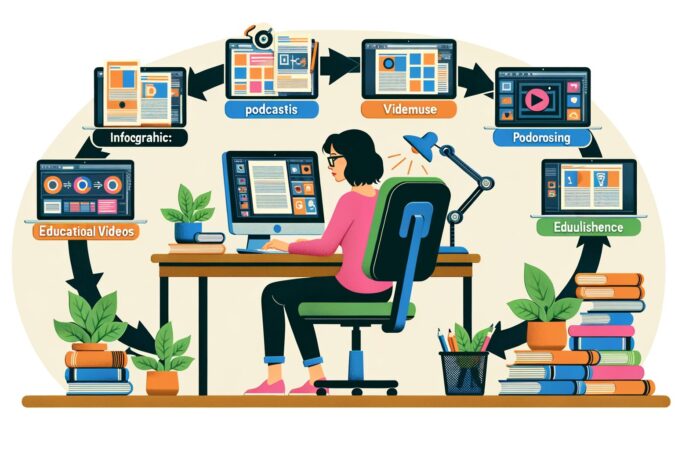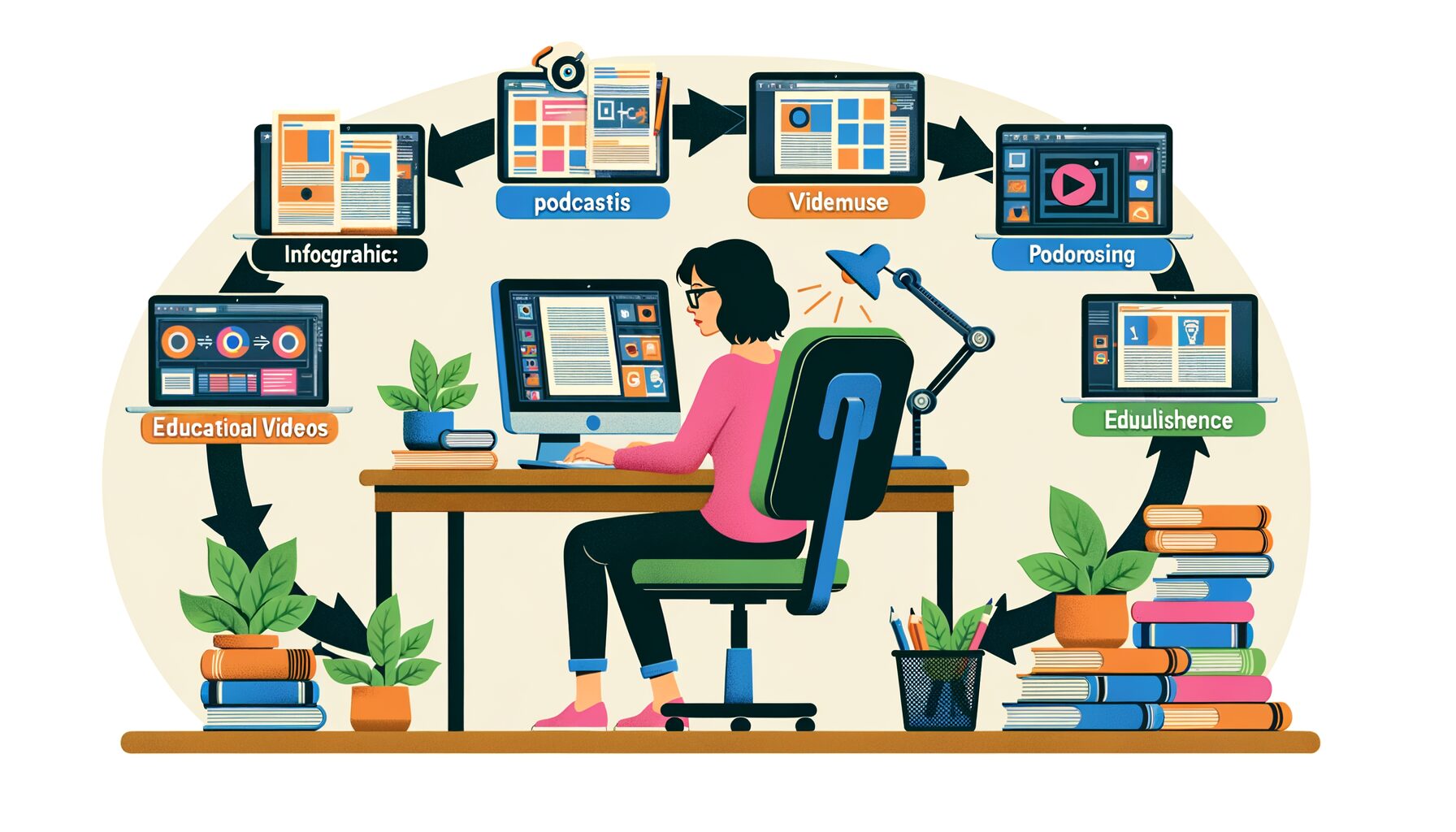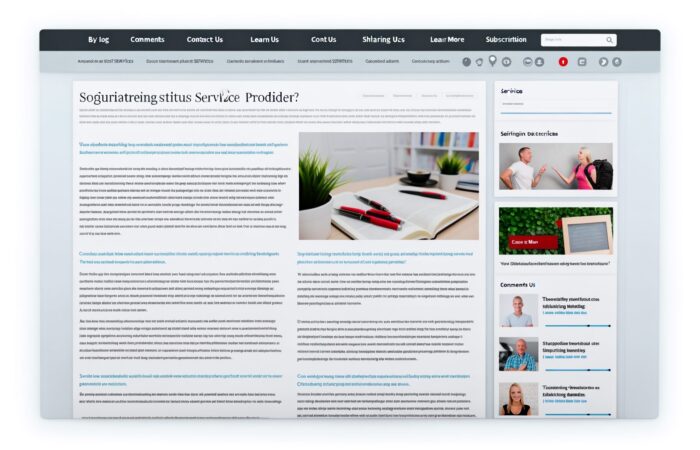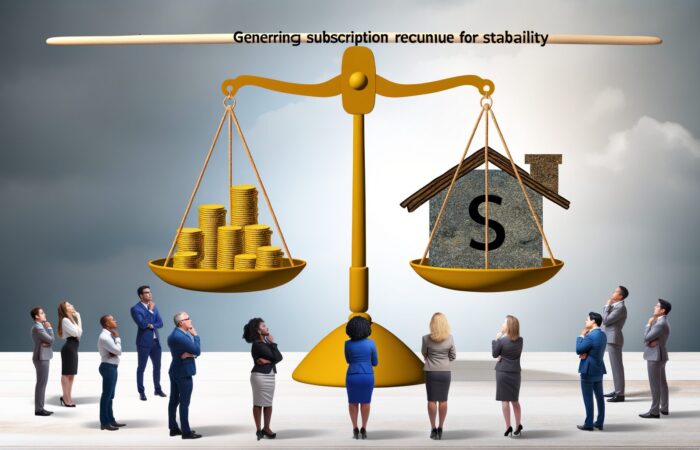Introduction to Content Repurposing
Ever wondered how you can get more bang for your buck when it comes to the content you create? Whether you’re a blogger, a podcast host, or even a business owner trying to boost your online presence, content repurposing is something you might want to consider. But what is it exactly? Sit back, grab your favorite snack, and let’s dive into the world of making your content work harder for you!
So, What is Content Repurposing?
Content repurposing, in a nutshell, is the art of taking one piece of content and reworking it to serve multiple purposes across various platforms. Think of it as recycling—but instead of turning plastic bottles into new products, you’re transforming, let’s say, a podcast episode into engaging blog posts, snappy social media snippets, or even a compelling video series.
It’s not just about copying and pasting existing content; it’s about reimagining that content in ways that appeal to different audiences or fit different formats. The core idea stays the same, but the way you present it evolves.
Why Consider Repurposing Content?
The reasons to jump on the content repurposing train are many, but let me share a few top ones:
- Reach a wider audience: Not everyone consumes content in the same way. While some love reading detailed articles, others might prefer listening on the go or watching a quick video. Repurposing content across various channels ensures that no part of your audience is left out.
- Boost your SEO: By repurposing content wisely, you can target a variety of keywords and get more mileage out of your SEO efforts. More formats mean more ways to be discovered!
- Save time and resources: Let’s face it, creating top-notch content from scratch is time-consuming and not always feasible. Repurposing content allows you to maximize the return on your original investment of time and creativity.
Imagine cooking a big, delicious meal. Wouldn’t it be great if you could turn the leftovers into another equally tasty dish instead of just reheating the same meal? That’s what we’re doing here but with your content—giving it a new flavor and presentation to delight your audience, all over again!
Getting Started
Ready to repurpose like a pro? Start by reviewing your current content. Look for pieces that performed particularly well or topics that are evergreen—you know, the ones that never go stale. These make the perfect starting points for repurposing.
Next, consider the formats that would best suit different segments of your audience or new audiences you’re aiming to reach. Always keep your end goal in sight, whether it’s to educate, entertain, or convert your audience into customers.
All set to start? Your journey in content repurposing is about to unfold, and I can assure you, it’s going to be an exciting one. See you at the intersection of creativity and strategy, where your content begins its new, vibrant life!
Understanding the Benefits of Repurposing Content
Hey there! Let’s dive into a topic that’s buzzing in the digital world—repurposing content. You’ve probably heard about it, but why is it such a big deal? Well, think about your favorite old jeans turned into a cool new denim bag. It’s kind of like that, but for content. Exciting, right? Let’s break down why repurposing content is not just smart, but also incredibly beneficial for your brand or business.
Maximizing Your Efforts
First off, content creation can be exhausting! Coming up with ideas, researching, and producing high-quality material takes a lot of time and energy. When you repurpose content, you get to breathe new life into something that already exists. This means you can maximize the initial effort you put into creating your primary content by spinning it into different formats. It’s like cooking a big meal and enjoying different variations of leftovers for days!
Broadening Your Reach
Think about this: not everyone likes to consume content in the same way. Some prefer reading detailed articles, while others might lean towards watching a quick video or listening to a podcast during their commute. By repurposing your original content into different formats, you’re effectively increasing your chances of reaching a wider audience. It’s about meeting people where they are and how they prefer to engage.
Enhancing Your SEO
Here’s a secret weapon—SEO! When you repurpose content, especially into forms like blogs, infographics, or videos, you create more opportunities to be seen and heard on search engines. Each piece of repurposed content can target various keywords, which can boost your visibility online. Imagine being the first result when someone Googles a topic related to your content. Pretty cool, huh?
Increasing Online Presence and Engagement
- More Touchpoints: Every new format of your content creates a new way to engage with your audience. More formats mean more touchpoints.
- Enhanced Engagement: Interactive formats like quizzes, infographics, or videos tend to engage users more deeply than text alone.
Getting the Most Out of Your Investment
Lastly, let’s talk money. Producing content is an investment, and repurposing helps ensure you get the most bang for your buck. By recycling content, you spread the cost over several pieces rather than just one, increasing your ROI (Return on Investment). If a piece of content really struck a chord, turning it from a blog post into a webinar or an e-book can perpetuate its success without substantial additional expense.
In conclusion, repurposing content isn’t just a time-saver; it’s a strategic move to amplify your content’s reach, lifespan, and impact. Whether you’re a solo blogger, a startup, or a large corporation, these benefits are universal. Ready to get more from your content? Start thinking about how you can turn that ‘one-hit-wonder’ into a full album of hit material!
Case Study: How a Podcast Became a Best-Selling Book
Hey podcast enthusiasts and book lovers! Have you ever wondered what it takes to transform the rich, engaging conversations of a podcast into a best-selling book? Let’s dive into an inspiring case study that might just prompt you to consider leveraging your own podcast content in new and exciting ways.
Imagine this: a podcast that started as a weekly exploration of historical events, drawing in listeners with its captivating storytelling and expert interviews. The creators didn’t know it then, but they were sitting on a treasure trove of content that was about to reach a whole new audience.
Identifying the Potential
The journey began when the podcast creators reviewed their episode analytics. They noticed particular episodes that had significantly higher engagement and shares. These episodes, rich with vivid historical narratives and striking details, were the perfect candidates for adaptation into a book format.
Curating the Content
The next step was content curation. The creators meticulously went through their top episodes, selecting the best snippets, quotes, and discussions. They organized these into a coherent structure that would not only appeal to their existing listeners but also to a brand new reading audience.
Collaboration with Writers
Writing a book is no small feat, and our podcasters knew that. They collaborated with a seasoned writer who specialized in historical narratives. This partnership was crucial in ensuring that the conversational tone of the podcast was preserved while still making the content accessible and engaging for book readers.
Engagement through Promotion
With the book nearing completion, the promotional strategies kicked in. The podcast continued to serve as a powerful platform, teasing book excerpts and discussing themes and stories from the upcoming publication. Social media campaigns and newsletter blasts also played a vital role, creating buzz and anticipation.
The Launch and Beyond
Finally, the book launched, and it was an instant hit! It climbed the best-seller charts, thanks in part to the loyal podcast audience who were thrilled to support the new format. The success didn’t stop there; new listeners who found the book first were drawn back to the podcast, creating a beautiful synergy between the two mediums.
Key Takeaways:
- Analytics are gold: Understanding what your audience loves most can guide your repurposing strategy.
- Collaborate: Bring in experts when venturing into new formats; their experience can be invaluable.
- Promote strategically: Use your existing platforms to create excitement and anticipation.
- Synergize: Allow your new content to feed back into your original platform, enhancing both.
This case study not only showcases the power of repurposing content but also underscores the importance of understanding and connecting with your audience in multiple formats. So, whether you’re a budding podcaster or a seasoned one, consider how your existing content might be turned into your very own best-seller. Who knows? The next big hit on the bookshelves might just be yours!
Turning Blog Posts into a YouTube Sensation!
Have you ever wondered why your favorite blog doesn’t have a video series? Well, you’re not alone! There’s something incredibly rewarding about watching a story come to life on screen. If you’re a blogger or content creator, let’s chat about morphing those written words into lively, engaging YouTube videos. Yes, it’s quite the exciting journey from text to video – and it’s totally doable!
Why YouTube, you ask? Well, YouTube is a powerhouse! It’s the second largest search engine in the world after Google. This means a massive audience potentially seeing your content. But there’s more to it than just exposure. Videos allow for a richer, more personal connection with your audience. They can see your expressions, hear your voice, and feel moved by your visual storytelling. It’s a whole different level of engagement!
1. Selecting Your Star Blog Posts
Start by picking blog posts that have already won the hearts of your readers. Look at the comments section: Which posts sparked the most conversation? Which ones were shared like crazy on social media? These are your golden tickets. These posts have proven their worth in words; now, let’s give them a voice and a face!
2. Scripting Your Video
Next up: the script. You can’t just read your blog post word for word – the screen demands a different kind of energy. Be conversational. Make your sentences shorter and punchier. And hey, feel free to add a bit of humor or a personal anecdote that wasn’t in the original post. Remember, videos need to be engaging and relatable!
3. The Visuals
Visuals matter! Think about what visuals or graphics can help underline your points. You don’t need Hollywood-style effects, but simple, neat visuals can make a significant impact. Can you use animations, or would live-action video work better? Maybe a mix of both? You’re telling a story, so make sure the visuals contribute effectively to that narrative.
4. Engaging with Your Viewers
Unlike blogs, videos directly ask for viewer interaction. Invite viewers to comment, share, and like your videos. Ask questions to engage them or suggest they subscribe for more similar content. Remember, YouTube not only favors good content but also viewer engagement when it comes to ranking videos.
5. Consistent Posting
Last but not least, consistency is crucial. Just like blogging, video creation benefits massively from regular posting. Set a schedule and stick to it. Whether it’s weekly or bi-weekly, let your audience know when to expect new content from you.
In conclusion, transforming your blog posts into a YouTube series not only breathes new life into your content but also taps into a broader audience, and builds a deeper relationship with your followers. Grab your camera, or even your smartphone, and start planning your first video. You’ll be amazed at how a familiar story can feel so fresh and invigorating when it’s told in a new way. Lights, camera, action!
Leveraging User-Generated Content Across Social Media Platforms
Have you ever scrolled through your social media feeds and noticed how some posts by brands seem particularly relatable and heartwarming? There’s a good chance what you’re seeing is user-generated content (UGC). UGC is not just a buzzword; it’s a phenomenal strategy to enhance your brand’s presence and create a community feel around it. Let’s dive into how you can use this strategy effectively!
First things first, what is user-generated content? It’s any form of content—like images, videos, texts, reviews, and more—that’s created by people, rather than brands. This kind of content is gold because it’s authentic and engaging. People tend to trust other customers more than they trust direct brand advertisements. And here’s how you can tap into this trustworthy resource:
- Encourage Sharing: Start by creating a hashtag that represents your brand or a specific campaign. Encourage your followers to use it while posting content related to your products. This not only fosters community but also makes it easier to track all posts related to your brand.
- Run Contests or Giveaways: Who doesn’t love freebies? Running a contest with a prize can motivate your audience to share innovative content about your brand. Just remember to clearly communicate how to enter and what the guidelines are for submissions.
- Feature Their Content: If someone takes the time to create and share something about your brand, featuring it on your platforms can be a powerful acknowledgment. It can motivate others to share more and feel valued by your brand. Plus, it shows that you’re listening.
Now you might wonder, “Isn’t this just boosting my brand’s image?” Well, yes, but it’s also so much more. By leveraging UGC, you are:
- Building Trust: When prospective customers see real people vouching for your product, it builds credibility and trust.
- Enhancing Engagement: UGC prompts more interactions from your audience since it’s relatable and genuine.
- Increasing Content Volume: Let’s be honest, constantly creating fresh content can be overwhelming. UGC offers a great supplement to your content strategy, keeping your feed fresh and vibrant without the constant heavy lifting on your part.
Let’s not forget about some potential pitfalls! Always remember to ask for permission before using someone’s content on your platforms. It’s just good etiquette. Also, keep an eye on the quality of the content you share. While authenticity is key, maintaining a certain standard is crucial to uphold your brand’s image.
In conclusion, user-generated content is a treasure trove for social media marketers. It’s a win-win; your users get a moment in the spotlight, and you get authentic content that resonates with your audience. So, why not give it a try? Start small, stay consistent, and watch your community thrive!
Turning Your Webinar into a Comprehensive E-Course
Are you sitting on a goldmine of webinar content and not sure what to do with it next? Well, you’re in luck because transforming your webinar into an e-course could be your next big move. This isn’t just about reaching more people; it’s about deepening engagement and creating a lasting resource that keeps on giving. Let’s dive in!
First things first, why repurpose a webinar? Webinars, by their nature, are informative and engaging. But once the live session ends, that rich content often sits underutilized. Converting it into an e-course not only extends its life but also enhances its value. Plus, with the shift towards digital learning, there’s a growing audience out there hungry for structured, self-paced educational content.
Step-by-Step Guide to Transformation
- Content Audit: Start by reviewing your webinar material. What key points were covered? Identify the core themes and any supplementary content that could enrich a more comprehensive course.
- Learning Objectives: Define clear learning objectives for your e-course. What should participants know or be able to do after completing the course? This will guide your content structuring.
- Structural Design: Decide how you want to structure your e-course. Will it be a series of short modules, or a few longer classes? Think about the flow and how participants will progress through the material.
- Add Interactivity: Unlike webinars, e-courses offer the chance to include interactive elements like quizzes, assignments, and discussion boards. This hands-on approach can significantly enhance the learning experience.
- Technical Checks: Choose the right platform to host your e-course. Ensure it supports the content format you’re envisioning and is easy for your audience to use.
- Marketing Magic: Don’t forget to market your new e-course. Use your existing channels to let your audience know about this new resource.
Real-Life Examples
Imagine you held a webinar on digital marketing trends. That could easily be expanded into an e-course covering in-depth strategies, case studies, and real-world applications of those trends. Perhaps you include guest lectures or interviews with experts, enhancing the original content and providing additional value to your learners.
Benefits to Look Forward To
- Broadened Reach: An e-course can reach an audience beyond those who can attend a live webinar.
- Flexibility: Learners can access the content at their own pace, on their own schedule.
- New Revenue Streams: Depending on your model, this could be a new revenue stream if you choose to charge for course access.
- Feedback Opportunities: Continuous input from students can help you refine and improve the content over time.
So, ready to transform your webinar into something bigger and better? With a plan in place and a dash of creativity, your e-course might just be the next big hit. Dive in, the digital learning community awaits!
Infographics and Their Impact in Repurposing Research Data
Let’s dive into something pretty cool but massively underrated—infographics. Have you ever seen those snazzy visuals filled with stats and facts, popping with colors, and just all-around captivating? Well, those are infographics, and they do more than just look pretty. They’re a powerhouse in communicating complex research data. So, why should you jump on this bandwagon? Let me unfold that for you!
Why Infographics Rock the Data World
First things first, infographics make information more digestible. Imagine sifting through a 30-page report brimming with data—that’s no walk in the park, right? Infographics can condense this into a single, engaging image. It’s like getting the gist of the story without having to read the whole book!
The Repurposing Magic
When it comes to repurposing research data, infographics are your best friend. Let me paint a scenario: you’ve got piles of research from a recent study. You know this information is gold, but how do you get it across without boring your audience to tears? That’s where infographics come in.
- Accessibility: By simplifying complex data into bite-sized, visually appealing pieces, you make the information accessible to a broader audience. Not everyone loves numbers, but everyone loves a good visual!
- Shareability: A well-designed infographic is more likely to be shared on social media, expanding its reach. This isn’t just good for traffic but is also fantastic for brand visibility and recognition.
- Memory Retention: Visuals help people remember information. By presenting data visually, you’re helping your audience not only understand but retain this information better.
Getting It Right
But here’s a little heads up—not all infographics are created equal. The key to a stellar infographic is not just in the design but also in how well it communicates the data. Here are a few tips for crafting infographics that not only look good but effectively convey the message:
- Keep it Focused: Don’t try to cram too much information into one infographic. Focus on a single theme or data set.
- Design Wisely: Use colors and graphics that reflect the mood of the data. And remember, clarity is king. The best infographics are often the simplest.
- Tell a Story: Structure your infographic as a story, with a beginning, middle, and end. This helps guide the viewer through the information in a logical way.
- Include Sources: Always credit your data sources. This not only adds credibility but also shows professionalism.
So next time you’ve got a heap of data and you’re pondering over how to present it, think infographics. Not only will it bring your data to life, but it will also ensure your audience gets the point, remembers it, and maybe even shares it! Now, isn’t that a triple win?











No Comment! Be the first one.